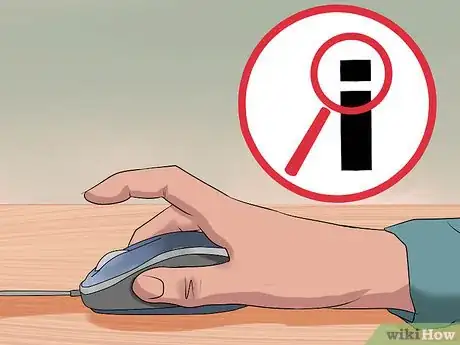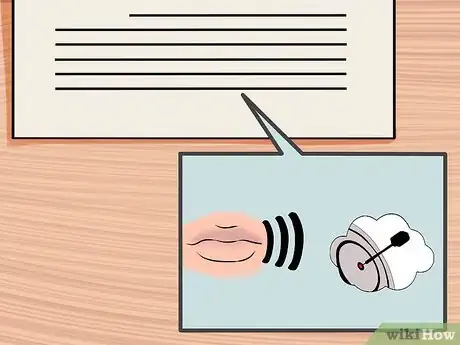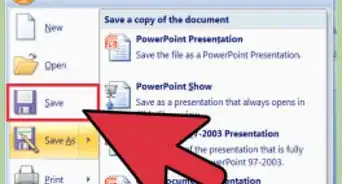This article was co-authored by Emily Listmann, MA. Emily Listmann is a private tutor in San Carlos, California. She has worked as a Social Studies Teacher, Curriculum Coordinator, and an SAT Prep Teacher. She received her MA in Education from the Stanford Graduate School of Education in 2014.
There are 10 references cited in this article, which can be found at the bottom of the page.
This article has been viewed 63,869 times.
While the topic, content, and environment in which oral reports are given widely varies, there are some common steps you can take that will ensure you’re ready to give for an oral report of any type. After assembling the proper materials, practice extensively and edit as you develop the report to convey your points concisely. With a bit of preparation and a healthy amount of practice, you can give your report with both clarity and confidence.
Steps
Finding and Assembling Material for an Oral Report
-
1Do some preliminary information gathering. Ask yourself: What are you hoping to convey? Your answer to this question should be the guiding principle for compiling your report. In order to inform, explain, and maybe even convince your audience, you need to be well versed in the topic you’re presenting on.[1]
- Initially, you just want to familiarize yourself with the topic. Most Wikipedia articles do a great job of including both the important facts and the tantalizing points of interest.
- Keep in mind that many teachers and professors won't accept Wikipedia as an academic source. These articles are great for familiarizing yourself with a topic. Once you know the basics, though, you will need to use sources such as books and journals for citations.
-
2Follow-up on interesting and important information. Take note of the facts and concepts that interest you or otherwise stand out. If you ever find yourself surprised by something you read while researching, make a point of referencing it in your report. Note that the footnotes of Wikipedia articles can provide you with a slew of citable sources, making your time spent researching especially fruitful.[2]
- Double check any sources you're unsure of or intend to rely upon heavily.
Advertisement -
3Use Google Scholar to research points that need strong evidence. Ask yourself what more you need to know to make a convincing point. This will help guide your specific search queries.[3] More specifically, use Google Scholar to bring in some peer-reviewed, academic and scientific articles.
- Most of the content generated by Google Scholar will be firsthand research publications, which are the strongest form of reference there is.
- Don’t fall for the temptation to pepper your audience with as much info as you can fit into the presentation.
- Emphasize the one or two key elements of your presentation, and include further material only insofar as it supports those points.
-
4Gear your report to the audience. While researching for the specific content you’ll share with your audience, think about who you’re giving the report to. The audience – whether your fellow grade school classmates or a few other PhD candidates at your university – will have backgrounds and knowledge relevant to how you’ll structure your report.[4]
- In particular, think about what a good entry point to the content of your report may be, considering your audience.
- Write down three different opening points, based on what will generate the interest of those you’re speaking to.
-
5Include a short, clear introduction. It can be tempting to try to win your audience over as soon as you begin speaking. Instead of leading with your best stuff, save it until after you’ve gotten everyone listening. To do this, introduce yourself, and the topic of your report in a few sentences. Articulate your specific objective in giving the report, and explain to your audience how you’ll achieve this objective.[5]
- For instance: “Hello, my name is __________, and today I’ll be talking about __________. My intention is to [share with / inform / convince] you [about / that] ____________. I will do so by first _______, then ________, and wrapping up with _________.”
-
6Maintain a logical flow. Throughout your report, maintain the logical flow that you outline in your introduction. In simplest terms, make sure there’s a clear beginning, middle, and end. Emphasize your key points whenever possible; in fact, you should rarely, if ever, digress from material that directly contributes to your objective of driving home one or two main points.[6]
- If you encounter a roadblock when organizing your material, think about what approach will most likely be understood by your audience.
- In general, address your simplest and most basic arguments first, and then move into your more complex arguments.
-
7Use your conclusion to convey gratitude and repeat your main point. Throughout your report, you’ll address specific supporting material that will culminate in a convincing presentation of your main points. As you develop the conclusion, be sure to explicitly restate your main points. Thank the audience for the their time, and welcome any questions they might have.[7]
-
8Compile your sources into an organized list. As you encounter sources you know you’ll use, immediately add them to a running list, perhaps with its own file. As you put the list together, use whatever format your teacher or professor prefers. The end of the report is usually the best place to include your references, and you do not necessarily need to actually reference your sources out loud.[8]
- You should verbally cite your sources if you followed their reasoning closely or if your report was based mostly on one or two sources.
Practicing and Fine-Tuning Your Oral Report
-
1Make yourself notecards. Even if you do not intend to use notecards while giving your report, make some to help you condense the material you hope to cover and to help you practice giving your report. Paraphrase your key points and write them in bullet format. Reducing your points into bullet points will ensure you memorize the supporting material as you practice, and will be able to give the report while looking at your audience.
- Summarize subsidiary points into one word, if possible. This will ensure you do not forget them, but will also not be sidetracked by focusing too much on a tangential point.
- Include hard facts and statistics in your notecards too, especially numerical data, as it is beneficial to have these on hand for immediate reference.
-
2Default towards brevity. Though it may feel as though more material means more support, more material may also increase the chances that your audience will lose track of your main point. The more concise you are, the more clear your report will be. Further, too much material risks running over your allotted time and increases the chances you lose track of your train of thought while giving your report.[9]
- Save nuanced dialogue for a question and answer session, if one will be allowed. Hint at controversial or otherwise commonly contended points, and anticipate addressing at least one additional response to such a challenge if it is raised.
-
3Practice, practice, practice! If there’s one thing that will improve the quality of your report, it’s plenty of practice giving the report. A great benchmark to shoot for while practicing is the ability to give the entire report without looking at your notes.[10]
- While practicing, stick to the material you’ve included – tangents are confusing for the audience and will eat your time more quickly than you realize.
-
4Time yourself while practicing. Especially if giving oral reports is a new experience for you, timing yourself can help prevent certain bad habits by reassuring you that you’re on track. Incorporate any visuals into your practice regimen, in part because they will help you stay on track and maintain your timing.[11]
- As an example, a 10-minute oral report should be practiced to the point you can give it in 9 to 9.5 minutes.
- With such a time allotment, spend a maximum of 1 minute on your introduction, with 7 to 7.5 minutes on the body of your report, and 1 to 1.5 minutes left to conclude.
-
5Curate the visual components of your presentation. Visuals are an important component of oral reports, since they help your audience contextualize presentation. Too many slides or visual aids can be distracting, though.[12] Keep the number of visuals you use at or lower than the number of minutes in your presentation. If, for example, you have a 15-minute presentation with an accompanying slideshow, aim to have 13-16 well-curated slides.
- Decide which visuals best suit your presentation based on their ability to support what you’re saying verbally.
- Try to keep your visuals clean and professional. An overabundance of colors, font styles, or showy effects and animations can distract from your presentation.
- In the visuals that you do include, default towards simplicity. If you’re including a graph, for instance, only plot the data and include the labels necessary to make your point, along with the source for the graph or data used.
-
6Fine-tune the amount of material you include to your allotted time. While accounting for what your audience can be expected to already be familiar with, make sure to only cover necessary information. Over-explaining simple concepts is a sure fire way to lose an audience’s interest, and this is the stuff that can usually be cut down to size while editing the amount of content in your report. Further, people’s attention spans are objectively limited.[13]
- For a scripted oral presentation, know that a 10-minute presentation will likely run from 900 to 1200 words.
-
7Record yourself giving your presentation. Record and listen or video record and view yourself giving your report. This will remind you of anything you may still need to work on. Watch for opportunities to adjust content, as well as signs of any potential bad habits – you’ll be better able to break these habits after witnessing them for yourself.[14]
Giving Your Report with Clarity and Confidence
-
1Address the audience directly. There are several physical components of giving a great oral report. Foremost among them, you must look at your audience! Maintain general eye contact by scanning from person to person. Use hand gestures while making especially important points, but take care not to wave your hands around the whole time you’re speaking.[15]
- Make sure your body language reflects engagement and enthusiasm by standing up straight and holding still, though comfortably so.
- Another benefit of making eye contact is that this allows you to gauge your audience. If faces are starting to go blank: slow down, speak more loudly, and give more illustrative examples of the points you’re making.
-
2Fight your nerves. Understand that’s totally okay to feel nervous about giving an oral report. Remind yourself that you’re prepared, rehearsed, and organized – all that’s left is to share it with the audience. Take a few deep breaths before taking the podium and picture yourself nailing it as you prepare to begin.[16]
- If you’re nervous, you may wind up speaking too quickly or too softly without thinking about it. Stay aware of your voice and the speed with which you’re speaking.
- Smile. Not only will this help engage your audience, it’ll help calm you down!
-
3Emphasize and reiterate what you want your audience to remember. Don’t forget to hammer your key points in the conclusion to drive them home. A great way to do this is slowing down as you build up to your closing statements, and pause immediately before and after the key points – this will allow you to collect yourself, and allow your audience to absorb the information you’re hoping to convey.[17]
-
4Break up the amount of time the audience spends listening to you. Keep your audience engaged throughout your report by giving them small breaks as you speak. You may include a "think-pair-share" activity by asking your audience a specific question, having them discuss it with the person next to them, then offering to share their ideas. You can also include short activities to help your audience solidify their understanding of your topic.[18]
-
5Allow time for questions. You can take questions as you give your report, or you can reserve time at the end of your speech. Either way, your audience should have the chance to directly address you while you're in front of them.[19]
- Try to prepare for questions in advance. Look over your report and find points of confusion and possible counter-arguments. Draw up a few points relevant to your anticipated questions so that you'll have them ready the day of your presentation.
- If, for example, you're presenting on financial planning to a group of college students, it's likely that many but not all of them will understand the difference between a 401(k) and an IRA. Write a notecard with the definitions of each just in case you get a question asking for clarification.
References
- ↑ https://www.gvsu.edu/ours/oral-presentation-tips-30.htm
- ↑ https://www.gvsu.edu/ours/oral-presentation-tips-30.htm
- ↑ https://library.shsu.edu/research/guides/tutorials/googlescholar/index.html
- ↑ http://www.ncbi.nlm.nih.gov/pmc/articles/PMC1857815/
- ↑ https://chem.duke.edu/undergraduate/oral-reports
- ↑ http://www.ncbi.nlm.nih.gov/pmc/articles/PMC1857815/
- ↑ https://www.hamilton.edu/academics/centers/oralcommunication/guides/introductions-and-conclusions
- ↑ https://www.uow.edu.au/student/learning-co-op/assessments/presentations/
- ↑ http://www.ncbi.nlm.nih.gov/pmc/articles/PMC1857815/
- ↑ https://www.gvsu.edu/ours/oral-presentation-tips-30.htm
- ↑ https://graduate.unl.edu/connections/ten-simple-rules-making-good-oral-presentations
- ↑ https://graduate.unl.edu/connections/ten-simple-rules-making-good-oral-presentations
- ↑ https://www.uow.edu.au/student/learning-co-op/assessments/presentations/
- ↑ http://www.ncbi.nlm.nih.gov/pmc/articles/PMC1857815/
- ↑ https://urca.msu.edu/orals
- ↑ https://www.uow.edu.au/student/learning-co-op/assessments/presentations/
- ↑ http://www.ncbi.nlm.nih.gov/pmc/articles/PMC1857815/
- ↑ http://www.readingrockets.org/strategies/think-pair-share
- ↑ https://www.uis.edu/ion/resources/oiai/oral-reports
















































































Medical Disclaimer
The content of this article is not intended to be a substitute for professional medical advice, examination, diagnosis, or treatment. You should always contact your doctor or other qualified healthcare professional before starting, changing, or stopping any kind of health treatment.
Read More...